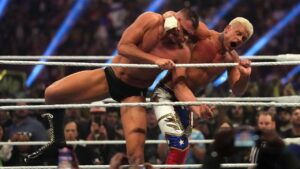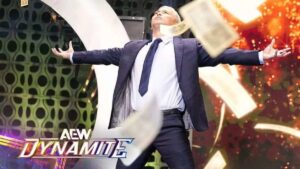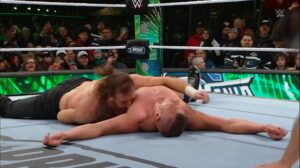It’s a trademark passed down by generations of Japanese wrestlers – the devious characters who, in their moment of need, dig down into some guttural supernatural space in their bellies (or poison glands, depending on the kayfabe), and spew forth a poisonous colored mist from their mouths, blinding their opponents. In Japanese, it’s called dokugiri (which means “poison fog”), but to many it’s simply referred to as the Asian mist. And much like Superman’s kryptonite, the color of the mist actually means different “strains” of potency. And while it’s been almost primarily used by Asian male wrestlers, it actually has its origins in the US territory days, beginning with The Great Kabuki in the early 1980s.
THE GREAT KABUKI

For nearly 20 years, Akihisa Mera wrestled as your standard Japanese wrestler. He started as a 16 year old in 1964 with Rikidozan‘s Japanese Wrestling Association (JWA), under the name Akihisa Takachihō, before heading Stateside to work for NWA Hollywood in 1970. He soon began working in Canada as well, working with the Tunney’s in Maple Leaf Wrestling (where he used Mr. Sato). He returned to Japan in 1973 and began a six year run with All-Japan Pro Wrestling (AJPW), before once again returning to the United States. It was with World Class Championship Wrestling (WCCW) that Takachihō was rebranded and christened the Asian mist to the rest of the world. Takachihō was paired with manager Gary Hart, who changed him into The Great Kabuki. As The Great Kabuki, he wore a visually striking mask (apparently caused by “burns”), and during that period he began to use the green Asian mist for the first time. He returned to AJPW in 1984, bringing the Asian mist back to Asia for its first time. He’s since gone on to enjoy a 50-year career that is still ongoing – he last wrestled in December for Pro Wrestling NOAH.
KENDO NAGASAKI

The second man to carry that name in wrestling (although the first Asian, as Kendo Nagasaki was originally a masked wrestler with a British white man under the mask), Nagasaki was a 1970’s All-Japan wrestler who also moved to the United States in the 1980s and worked in multiple NWA territories, including Mid-Atlantic and Championship Wrestling From Florida (CWF), plus stints in Stampede Wrestling and WCCW. Shortly after Kabuki began using the Asian mist as part of his arsenal of tricks, Nagasaki also began to use it in his various television tapings in the US, although his usage was far less frequent that Kabuki’s.
KILLER KHAN

Masashi Ozawa had been a star for NJPW throughout the 1970s before he made the journey to North America in the 1980s. Now called Killer Khan, he worked the NWA territories first – FCW, Georgia Championship Wrestling and Mid-South predominantly – before a short stint with the WWF in 1981 and 1982. He headed back to Japan, this time with All-Japan, but returned briefly in 1987 to the WWF, where he brought the Asian mist to a far larger mainstream audience.
https://www.youtube.com/watch?v=IgCJHftee1Q
THE GREAT MUTA

In 1989, Gary Hart introduced NJPW star Keiji Mutoh (who was briefly touring the USA and Puerto Rico as The Super Black Ninja) as The Great Muta in WCW, the twisted son of The Great Kabuki. Much like his “father”, Muta carried on the family legacy of spraying the green mist into opponents faces. While his WCW career never reached its full potential, he became an absolute icon in Japan, as a 4x IWGP Heavyweight Champion, 3x AJPW Triple Crown Champion, and 6x IWGP Tag Team Champion.
https://www.youtube.com/watch?v=DuCOx0UcWUo
KWANG

The first non-Asian to employ the Asian mist was a Puerto Rican masked wrestler known as Kwang, who debuted in the WWF in 1993. For Kwang’s duration, it was implied he was actually an Asian wrestler, but it was actually a man who would have a far more successful run in the WWF when he unmasked and was later known as Savio Vega.
YOSHIHIRO TAJIRI

“The Japanese Buzzsaw” made his wrestling debut a year after Kwang’s debut, starting with Michinoku Pro. In 1996, he moved to Mexico to work with CMLL. He’d make an appearance as part of NJPW’s Best of the Super Juniors in 1997 (in a tourney that featured Jushin Thunder Liger, Koji Kanemoto, Chris Jericho, Dr. Wagner Jr., Robbie Brookside and Chavo Guerrero Jr.) and exploded in the North American circuit in 1998 when he joined the original ECW. Following ECW’s demise, he joined the WWE where he had huge success for nearly five years, where he was a 3x WWE Cruiserweight Champion. Tajiri often employed different coloured mists beyond the standard green mist. He also employed a red “burning” mist and a black mist, that would blind opponents for weeks.
https://www.youtube.com/watch?v=0QCjlxWbPhc
LORD TENSAI

During the Attitude Era, NXT Head Trainer Matt Bloom was famously known as Prince Albert, the large pierced dude with Test and Trish Stratus in T’n’A. After an up and down run, he left in 2006 and headed to Japan, where he became one of NJPW’s top gaijin of the mid-2000s, as Giant Bernard. He was IWGP and GHC Tag Team Champion in Bad Intentions with current WWE Superstar and Bullet Club co-founder Karl Anderson. He returned to the WWE in 2012 with a Japanese character named Lord Tensai, bringing back the Asian mist to the WWE Universe for the first time since Tajiri’s departure.
https://www.youtube.com/watch?v=EGdgcUrvIeE
ROSEMARY

Rosemary has been one of the undisputed MVPs of the Impact Wrestling Knockouts division the past year, with great matches against Jade, Sienna, Laurel Van Ness and most recently, KC Spinelli. And if you’ve followed her with Smash Wrestling in her home country of Canada, you’ve seen her epic feud with Allie/Cherry Bomb. Rosemary’s demonic personality is the perfect vessel for a mist spewing. Although her least successful misting occured in 2016 when she attempted it on “Broken” Matt Hardy.
The Asian mist is being used more and more on the indie scene, and it’s a gimmick that has become a beloved footnote in the history of the business. From Kabuki to Rosemary and beyond, the Asian mist, the Poison Fog, the dokugiri, will forever be a part of pro wrestling lore.






